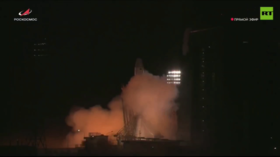Almost third more US West Coast newborns may face thyroid problems after Fukushima nuclear disaster

Researchers have discovered that the Fukushima nuclear disaster has had far-reaching health effects more drastic than previously thought: young children born on the US West Coast are 28 percent more likely to develop congenital hyperthyroidism.
In examining post-Fukushima conditions along the West Coast, researchers found American-born children to be developing similar conditions that some Europeans acquired after the 1986 meltdown of the Chernobyl Nuclear Power Plant.
“Fukushima fallout appeared to affect all areas of the US, and was especially large in some, mostly in the western part of the nation,” researchers from the New York-based Radiation and Health Project wrote in a study published by the Open Journal of Pediatrics.
Children born after the 2011 meltdown of Japan’s Fukushima Nuclear Power Plant are at high risk of acquiring congenital hyperthyroidism if they were in the line of fire for radioactive isotopes. Researchers studied concentration levels of radioiodine isotopes (I-131) and congenital hypothyroid cases to make the association.
Just a few days after the meltdown, I-131 concentration levels in California, Hawaii, Alaska, Oregon and Washington were up to 211 times above the normal level, according to the study. At the same time, the number of congenital hypothyroid cases skyrocketed, increasing by an average of 16 percent from March 17 to Dec. 31, 2011. And between March 17 and June 30, shortly after the meltdown, newly born children experienced a 28 percent greater risk of acquiring hyperthyroidism.
In 36 other US states outside of the exposure zone, the risk of congenital hyperthyroidism decreased by 3 percent – a finding that researchers believe may serve as further proof that Fukushima had something to do with the unusually high results found on the West Coast.
The disease is usually rare, but can manifest into a serious condition if left untreated. Affected fetuses and children may suffer serious developmental delay – and a recent report found that 44.2 percent of 94,975 sampled Fukushima children have had thyroid ultrasound abnormalities as a likely result of their exposure to the radiation.
Americans often doubted that radiation from the meltdown would affect the US West Coast, but the latest research sheds light on alarming scientific data that indicates otherwise. Radioactive iodine that enters the human body typically gathers in the thyroid, which release growth hormones. Radiation exposure can therefore stunt the growth of a child’s body and brain. Exposure can have long-lasting effects, which scientists have studied in those who were near the Chernobyl nuclear power plant during its 1986 meltdown. Decades after the accident, a 2011 study by the National Institutes of Health found that higher absorption of I-131 radiation led to an increased risk for thyroid cancer among victims of Chernobyl radiation – a risk that has not diminished over time.
The children who were unfortunate enough to be exposed to Fukushima radiation on the US West Coast, Alaska or Hawaii could face similar risks of congenital hypothyroidism or thyroid cancer throughout their lives, although the Radiation and Health Project Researchers said they are still investigating further to see what other factors might be involved in their findings before drawing any solid conclusions about the effects of Fukushima.
CORRECTION: The title of this article
was changed to reflect a more accurate explanation of the statistic
in question. We regret the error.














